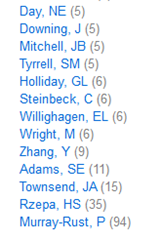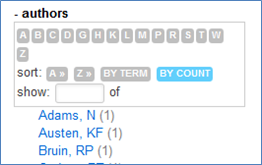I am really excited about BibSoup. It didn’t really click till last night how easy and powerful it is. I think it will be very important. Here’s a summary and then we show you how YOU can use it. It literally takes 3 minutes to learn and probably 10 to create your own bibliography (if you already have the data).
- It’s trivial to load and use. Yes, really trivial.
- It’s free-as-in-beer. You pay nothing. Mark and colleagues have done all the work.
- It’s Open as free-as-in-speech. Everyone can see my bibliography. And vice versa. (Of course I can download and run my private instance if I wish). Anyone can download the software, or any of the content. There are no walled gardens. The entries are CC0 and the collections are CC0.
- There’s a vibrant community. If you have an idea you are an equal. If it’s a good idea you can convince the community it’s worth high priority (we are a meritocracy). You can work contribute in a communal system.
- Everything is re-usable. If I want to teach about polymers I can search Karol Langner’s bibliography and copy references.
- It’s extensible. BibJSON makes it trivial to add new fields – e.g. pointing to datasets, images, commentaries, etc. As a community we shall certainly be building new tools – there are so many ideas that are now possible.
- And it’s powerful. Bibliography is now an instrument of 21st C web democracy. It’s the roadmap of scholarship.
Now I show how anyone can create their own Bibserver and populate it.
I’m going to upload my publication list from the Symplectic system at Cambridge. It will probably have errors and infelicities. ALL bibliographic collections have errors and infelicities. It starts:
@article{murray-rust2011semanticview.,
author = “Murray-Rust, P”,
journal = “J Cheminform”,
month = “Oct”,
pages = “48”,
title = “Semantic science and its communication – a personal view.”,
volume = “3”,
year = “2011”,
abstract = “ABSTRACT: The articles in this special issue represent the culmination of about 15 years working with the potential of the web to support chemical and related subjects. The selection of papers arises from a symposium held in January 2011 (‘Visions of a Semantic Molecular Future’) which gave me an opportunity to invite many people who shared the same vision. I have asked them to contribute their papers and most have been able to do so. They cover a wide range of content, approaches and styles and apart from the selection of the speakers (and hence the authors) I have not exercised any control over the content.”,
doi = “10.1186/1758-2946-3-48”,
eissn = “1758-2946”,
issue = “1”,
language = “ENG”,
pii = “1758-2946-3-48”,
day = “14”,
}
…
This is in BibTeX and that’s all we need to know – Bibserver does the rest. So let’s go there (http://bibsoup.net/ ). We need the first box:

I have previously registered (it’s trivial) so no I have

It’s not all my publications, but the most recent ones.

So now we can start browsing.
Yes, WE. If you go to http://bibsoup.net/petermr/peter_murray_rust_publication_list/ you can do everything I can do! Bibliography is truly Open!
It’s very easy. Let’s see the years:

[I have more publications – I think this concentrates on the last 10 years].
And who are my most prolific co-authors? Use the author button:

Let’s see who has contributed most to Chemical Markup Language (CML). “CML” is a good search term for a small collection like this (I haven’t published on Chronic myelogenous leukemia). We get:

19 publications.
Let’s see the authors:

(and 50+ more). Display them as a bubble diagram:

Which gives:

Showing that (of course) my CML-symbiote is Henry Rzepa.
Let’s see what CML papers I have published with Joe Townsend. Just click on the bubble and get:

Now let’s look at my journals – see if you can work out for yourself how I get:

So my favoured journal is J. Cheminform. which is an Open Access journal published by BiomedCentral. But look at its neighbours:
- J. Chem Inf Model
- J CHEM INF COM SCI
- J Chem Inf Comput Sci
They are actually all the same journal!! That’s because it changed its name from JCICS to JCIM some years back. And because there is no consistency in abbreviations. So the idea that we can have one true global platonic bibliography is a myth – we shall never achieve it. We may get close in some areas but there will always be differences of opinion about “sameAs” and different practices.
So try it out. At present it does BibTeX and hopefully very shortly it will do RIS/Endnote.
So what happens when we get thousands of bibliographies? Won’t we need a tool to search for bibliographies?
Yes, and I think we have some ideas J
Does it support CiTO, the Citation Typing Ontology, or are there plans to support that?
For just a bibliographic list, I already have CiteULike and Mendeley… how is this better, besides the explicit CC0 license on the data?
>>Does it support CiTO, the Citation Typing Ontology, or are there plans to support that?
It supports any field/facet that has a namespaced ontology and whose data is either a string or a JSON object. If, therefore, we created a bibliography for a given article then it’s possible to add “cito:foobar” as a keyword. If that suffices for what you want to do, then yes.
>>For just a bibliographic list, I already have CiteULike and Mendeley… how is this better, besides the explicit CC0 license on the data?
I will write a blog post on this. I’ll just ask here “how is JChemPaint better than JME?”
Pingback: Open Biblio 2 « A Man of Badly Encoded Character